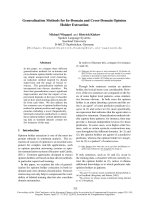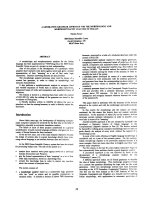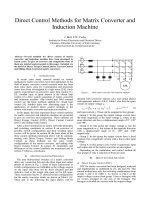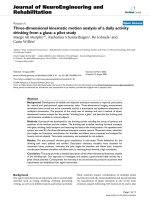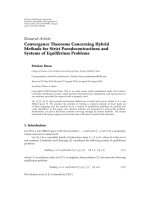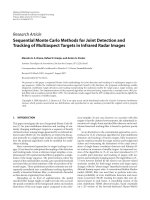Development of meshfree methods for three dimensional and adaptive analysis of solid mechanics problems
Bạn đang xem bản rút gọn của tài liệu. Xem và tải ngay bản đầy đủ của tài liệu tại đây (2.93 MB, 244 trang )
DEVELOPMENT OF MESHFREE METHODS FOR
THREE-DIMENSIONAL AND ADPATIVE ANALYSES OF
SOLID MECHANICS PROBLEMS
ZHANG GUIYONG
NATIONAL UNIVERSITY OF SINGAPORE
2007
DEVELOPMENT OF MESHFREE METHODS FOR
THREE-DIMENSIONAL AND ADAPTIVE ANALYSES OF
SOLID MECHANICS PROBLEMS
ZHANG GUIYONG
(B.Eng., DUT, CHINA)
A THESIS SUBMITTED
FOR THE DEGREE OF DOCTOR OF PHILOSOPHY
DEPARTMENT OF MECHANICAL ENGINEERING
NATIONAL UNIVERSITY OF SINGAPORE
2007
Acknowledgements
i
Acknowledgements
I would like to express my deepest gratitude and appreciation to my supervisor,
Professor Liu Gui-Rong for his dedicated support, invaluable guidance, and continuous
encouragement in the duration of the study. His influence on me is far beyond this thesis
and will benefit me in my future research work. I am much grateful to my co-supervisor,
Dr. Wang Yu-Yong, for his inspirational help and valuable guidance in my research wrok.
I would also like to thank Dr. Gu Yuan-Tong for his helpful discussion, suggestion,
recommendations and valuable perspectives. To my friends and colleagues in the ACES
research center, Miss Zhang Ying-Yan, Miss Cheng Yuan, Dr. Dai Ke-Yang, Mr. Li Zi-
Rui, Dr. Li Wei, Dr. Deng Bin, Mr. Zhou Cheng-En, Dr. Zhao Xin, Mr. Kee Buck Tong
Bernard, Mr. Zhang Jian, Mr. Song Cheng-Xiang, Mr. Khin Zaw, Mr. Nguyen Thoi
Trung, I would like to thank them for their friendship and help.
To my family, my parents and my elder sister, I appreciate their encouragement and
support in the duration of this thesis. With their love, it is possible for me to finish the
work smoothly.
I appreciate the National University of Singapore for granting me the research
scholarship which makes my study in NUS possible. Many thanks are conveyed to Center
for Advanced Computations in Engineering Science (ACES) and Department of
Mechanical Engineering, for their material support to every aspect of this work.
Table of contents
ii
Table of contents
Acknowledgements i
Table of contents ii
Summary vii
Nomenclature x
List of figures xiii
List of tables xx
Chapter 1 Introduction 1
1.1 Overview of meshfree methods 1
1.1.1 Introduction 1
1.1.2 Features and properties of meshfree methods 3
1.2 Literature review 5
1.2.1 Meshfree shape function construction techniques 6
1.2.2 Meshfree methods based on strong forms 10
1.2.3 Meshfree methods based on Galerkin weak forms 11
1.2.4 Meshfree methods based on combination of weak and strong forms 17
1.3 Objectives and significance of the study 18
1.4 Organization of the thesis 19
Chapter 2 Point interpolation method (PIM) 21
2.1 Introduction 21
2.2 Polynomial point interpolation method (Polynomial PIM) 23
2.2.1 Polynomial PIM formulation 23
Table of contents
iii
2.2.2 Properties of polynomial PIM shape functions 25
2.2.3 Techniques to overcome singularity in moment matrix 27
2.3 Radial point interpolation method (RPIM) 29
2.3.1 RPIM formulation 29
2.3.2 Properties of RPIM shape function 33
2.3.3 Implementation issues 34
2.4 Moving least square (MLS) approximation 35
2.4.1 MLS formulation 36
2.4.2 Weight function 39
2.4.3 Properties of MLS shape functions 40
Chapter 3 Meshfree radial point interpolation method (RPIM) for three-
dimensional problems 44
3.1 Introduction 44
3.2 Radial point interpolation method (RPIM) in three-dimensions 44
3.3 Formulations 48
3.4 Implementation issues 50
3.4.1 Background mesh and numerical integration 50
3.4.2 Two models of support domain 51
3.5 Numerical examples 52
3.5.1 Analysis of shape parameters through function fitting 52
3.5.2 A 3D cantilever beam 56
3.5.3 Lame problem 59
3.5.4 A 3D axletree base 60
Table of contents
iv
3.6 Remarks 62
Chapter 4 A nodal integration technique for meshfree radial point interpolation
method (NI-RPIM) 74
4.1 Introduction 74
4.2 Discretized system equations 76
4.3 Nodal integration scheme based on Taylor’s expansion 78
4.3.1 Formulations of nodal integration for 1D problems 80
4.3.2 Formulations of nodal integration for 2D problems 82
4.4 Numerical examples 84
4.4.1 A one-dimension bar subjected to body force 84
4.4.2 A one-dimensional problem with non-polynomial solution 85
4.4.3 A cantilever beam 86
4.4.4 An infinite plate with a hole 89
4.4.5 Internal pressurized hollow cylinder 91
4.4.6 An automotive part: connecting rod 91
4.5 Remarks 92
Chapter 5 Linearly conforming point interpolation method (LC-PIM) for two-
dimensional problems 108
5.1 Introduction 108
5.2 Briefing on the finite element method (FEM) 110
5.2.1 Basic formulation 110
5.2.2 Some properties of FEM 112
5.3 Formulations of LC-PIM 114
Table of contents
v
5.3.1 Construction of PIM shape functions 114
5.3.2 Discretized system equations 116
5.3.3 Nodal integration scheme with strain smoothing operation 117
5.3.4 Comparison between LC-PIM and FEM 120
5.4 Variational principle for LC-PIM 123
5.4.1 Weak form for LC-PIM 123
5.4.2 Upper bound property of LC-PIM 128
5.5 Numerical examples 137
5.5.1 Standard patch test 137
5.5.2 Cantilever beam 138
5.5.3 Infinite plate with a circular hole 140
5.5.4 Semi-infinite plane 141
5.5.5 Square plate subjected to uniform pressure and body force 143
5.5.6 An automotive part: connecting rod 143
5.6 Remarks 144
Chapter 6 Linearly conforming point interpolation method (LC-PIM) for three-
dimensional problems 160
6.1 Introduction 160
6.2 Polynomial point interpolation method in three-dimensions 161
6.3 The stabilized nodal integration scheme in three-dimensions 163
6.4 Numerical examples 166
6.4.1 Linear patch test 166
6.4.2 A 3D cantilever beam 167
Table of contents
vi
6.4.3 3D Lame problem 168
6.4.4 3D Kirsch problem 169
6.4.5 An automotive part: rim 170
6.4.6 Riser connector 171
6.5 Remarks 172
Chapter 7 Adaptive analysis using the linearly conforming point interpolation
method (LC-PIM) 186
7.1 Introduction 186
7.2 Adaptive procedure 189
7.2.1 Error indicator based on residual error 189
7.2.2 Refinement strategy 190
7.3 Numerical examples 191
7.3.1 Infinite plate with a circular hole 191
7.3.2 Short cantilever plate 193
7.3.3 Mode-I crack problem 194
7.3.4 L-shaped plate 195
7.4 Remarks 196
Chapter 8 Conclusions and recommendations 207
8.1 Concluding remarks 207
8.2 Recommendations for further work 210
References 211
Publications arising from thesis 222
Summary
vii
Summary
Meshfree methods have been developed and achieved remarkable progress in recent
years. These methods have been shown to be effective for different classes of problems.
These methods have provided us many numerical techniques and extended our minds in
the quest for more effective and robust computational methods.
This thesis focuses on the development of new meshfree methods and the application
of these methods for three-dimensional problems and adaptive analysis. The work of the
present study can be devided into three parts: the first is to extend the meshfree radial
point interpolation method (RPIM) for three-dimensional problems; the second is to
develop a stabilized nodal integration scheme for the meshfree RPIM; the third is to
develop a linearly conforming point interpolation method (LC-PIM) for both 2D and 3D
problems, and to apply it to adaptive analysis.
The RPIM was originally proposed for 2D problems and applied for different types of
problems. The first contribution of the thesis is to formulate the RPIM to 3D solid
mechanics problems. In the 3D RPIM, basis functions composed of radial basis functions
(RBFs) augmented with polynomial terms and a set of nodes in the local support domain
of the point of interests have been employed to construct the shape functions. The RPIM
shape function possesses the Delta function property and essential boundary conditions
can be imposed straightforwardly at nodes. Some 3D numerical cases are studied and
effects of the shape parameters are investigated via the numerical results. The results
show that the RPIM has a very good performance for the analysis of 3D elastic problems.
Summary
viii
To improve the efficiency of the RPIM, a nodal integration scheme based on Taylor
expansion is proposed in place of the original Gauss integration. The second part is
focusing on developing a nodal integration scheme for the RPIM (NI-RPIM). In this
method, RPIM shape function is used and Gakerkin weak form is used for creating
discretized system equations, in which a nodal integration scheme is employed for
numerical integration. The nodal integration scheme is stabilized by using Taylor’s
expansion up to the second order. The NI-RPIM can obtain stable numerical results.
Compared with the RPIM using Gauss integration, the NI-RPIM achieves higher
convergence rate and efficiency; compared with the FEM with linear triangular elements,
the NI-RPIM obtains better accuracy and higher efficiency.
To obtain the compatibility and to achieve monotonic convergence in energy norm in
the numerical results for the polynomial PIM, a linearly conforming point interpolation
method (LC-PIM) is developed in the final part of the thesis. The LC-PIM has been
formulated for both 2D and 3D elastic problems and applied to the adaptive analysis. In
the LC-PIM, linear polynomial terms are employed for the construction of shape function
using point interpolation. The generalized Galerkin weak form is used to discretize the
system equations and a stabilized nodal integration scheme with strain smoothing
operation is used for numerical integration. The LC-PIM can guarantee the linear
exactness and monotonic convergence for the numerical solutions. Furthermore, the LC-
PIM possesses a very important property of upper bound on strain energy which is
demonstrated with a number of numerical examples. Results of the examples also show
that the LC-PIM can obtain better accuracy and higher convergence rate compared with
the FEM with linear triangular elements, especially for stress calculation. An adaptive
Summary
ix
analysis procedure using the LC-PIM is finally proposed, in which an error estimate
based on residual error and a simple refinement scheme have been introduced. Some
benchmark problems for adaptive analysis have been studied to demonstrate the validity
and effectiveness of the adaptive procedure for the LC-PIM.
In the thesis, the numerical implementation issues and effect of parameters for these
methods are described and discussed in detail. A large number of numerical examples are
studied using these methods and the results are compared with analytical solutions or
those obtained using other numerical methods. Theoretical analysis together with these
numerical examples have shown that the meshfree techniques presented in this study are
very effective and robust for three-dimensions and adaptive analysis of various solid
mechanics problems.
Nomenclature
x
Nomenclature
a
Coefficient vector
A
Area of the domain
b
Body force vector
B
Strain matrix
c
d
Average nodal spacing
s
d
Dimension of the local support domain
D
The stress-strain matrix of isotropic linear elasticity
E
Young’s modulus
d
e
Error in displacement norm
e
e
Error in energy norm
f
Force vector
G
Shear modulus
I
Moment of inertia of section
K
Stiffness matrix
L
Matrix of differential operator
n
L
Matrix of unit outward normal
n
Unit outward normal vector
n
Number of nodes in a local support domain
N
Total number of nodes located in the problem domain
()
xP
Polynomial basis function
Nomenclature
xi
n
P
,
m
P
Polynomial moment matrix
q
Parameter of MQ radial basis function
r
Distance
()
xR
Radial basis function
q
R
Moment matrix of RBFs
t
Specified traction vector
U
Displacement vector
u
Specified displacement vector
h
u
Approximation of function u
w
)
Smoothing function
[]
T
zyx=x
Cartesian coordinates
c
α
Parameter of MQ radial basis function
s
α
Coefficient for local support domain
Γ
Boundary of domain
t
Γ
Natural boundary
u
Γ
Essential boundary
δ
Kronecker delta
ε
Strain vector
ε
~
Smoothed strain vector
i
ϕ
Shape function component
Φ
Shape function vector
Nomenclature
xii
v
Poisson ratio
σ
Stress vector
θ
Rotation angle
Ω
Problem domain
k
Ω
Smoothing domain for node
k
List of figures
xiii
List of figures
Figure 2.1 The Pascal’s triangle 42
Figure 2.2 Illustration of local support domain 43
Figure 2.3 The approximation function and the nodal parameters in the MLS
approximation 43
Figure 3.1 Error in function fitting using RPIM shape functions with different q (MQ-
RBF augmented with linear polynomials is used with shape parameter
0.4=
c
α
and
Model-1 of the support domain is useed with
0.3
=
s
α
) 65
Figure 3.2 Error in function fitting using RPIM with different
c
α
(MQ-RBF augmented
with linear polynomials is used and Model-1 of the support domain is used with
0.3=
s
α
) 65
Figure 3.3 Convergence study of RPIM shape functions via function fitting (MQ-RBF
augmented with linear polynomials is used with shape parameter:
03.1=q and
0.4=
c
α
; Model-1 of the support domain is used with
0.3
=
s
α
) 66
Figure 3.4 A 3D cantilever beam subjected to a parabolic downward traction at the right
end 66
Figure 3.5 Effect of parameter q on the displacement results obtained using RPIM.
(Error is defined by Equation (3.41); a total of 1122 regularly distributed field nodes
and 500 hexahedron-shaped back ground cells are used; MQ-RBF augmented with
linear polynomials is used with shape parameter
0.4
=
c
α
and Model-1 of the
support domain is used with
0.3
=
s
α
). 67
Figure 3.6 Effect of parameter
c
α
on the displacement results obtained using RPIM.
(Error is defined by Equation (3.41); a total of 1122 regularly distributed field nodes
and 500 hexahedron-shaped back ground cells are used; MQ-RBF augmented with
linear polynomials is used with shape parameter
03.1
=
q
and Model-1 of the
support domain is used with
0.3
=
s
α
). 67
Figure 3.7 Effect of the dimension of the support domain on the RPIM (Error is defined
by Equation (3.41); a total 1122 regularly distributed field nodes and 500
hexahedron-shaped back ground cells are used; MQ-RBF augmented with linear
polynomials is used with shape parameter
03.1
=
q and
0.4
=
c
α
) 68
List of figures
xiv
Figure 3.8 Regular nodal distribution for the cantilever (A total of 2223 regular field
nodes and 1344 hexahedron-shaped background cells are used) 68
Figure 3.9 Irregular nodal distribution for the cantilever (A total of 1620 irregular field
nodes and 4447 tetrahedron-shaped background cells are used) 69
Figure 3.10 Displacement (
y
u
) distribution along the neutral axis (MQ-RBF augmented
with linear polynomials is used with shape parameter
03.1
=
q
and
0.4
=
c
α
;
Model-2 of the support domain is used, 52 and 55 field nodes are involved in the
support domain for regular and irregular nodal distribution respectively) 69
Figure 3.11 Normal stress distribution along the line of
2/Lx
=
,
0.0=z
(MQ-RBF
augmented with linear polynomials is used with shape parameter
03.1=q
and
0.4=
c
α
; Model-2 of the support domain is used, 52 and 55 field nodes are
involved in the support domain for regular and irregular nodal distribution
respectively) 70
Figure 3.12 Shear stress distribution along the line of
2/Lx
=
,
0.0=
z
(MQ-RBF
augmented with linear polynomials is used with shape parameter
03.1=q and
0.4=
c
α
; Model-2 of the support domain is used, 52 and 55 field nodes are
involved in the support domain for regular and irregular nodal distribution
respectively) 70
Figure 3.13 The Lame problem of a hollow sphere under internal pressure 71
Figure 3.14 Distribution of the radial displacement along the x axis for the Lame
problem 71
Figure 3.15 Distribution of the radial and tangential stresses along the x axis for the
Lame problem 72
Figure 3.16 3D model of an axletree base 72
Figure 3.17 Distribution of displacement
x
u
along Line 1 of the axletree base 73
Figure 3.18 Distribution of displacement
x
u
along Line 2 of the axletree base 73
Figure 4.1 Nodal integration domain for regularly distributed nodes for 1D problem 94
Figure 4.2 Nodal integration domain for irregularly distributed nodes for 1D problem . 94
Figure 4.3 Illustration of rectangular background cells and integral domain for node i in
two dimensions 95
List of figures
xv
Figure 4.4 Illustration of triangular background cells and the integral domain for node i
in two dimensions 95
Figure 4.5 Exact and numerical solutions of u and
dxdu /
for the one-dimensional bar
problem 96
Figure 4.6 Exact and numerical solutions of u for the one-dimensional problem with
trigonometric form of solution 96
Figure 4.7 Exact and numerical solutions of
dxdu /
for the one-dimensional problem
with trigonometric form of solutions 97
Figure 4.8 The convergence study of the present method by using the one-dimensional
bar problem (The convergence rate is about 1.94) 97
Figure 4.9 Cantilever beam subjected to a parabolic traction at the free end 98
Figure 4.10 Illustration of regular and irregular nodes distribution for the problem of
cantilever beam 98
Figure 4.11 Effect of parameter q on the displacement results for the cantilever beam 99
Figure 4.12 Effect of parameter
c
α
on the displacement results for the cantilever beam 99
Figure 4.13 Effect of dimension of the local support domain on the displacement results
for the cantilever beam (196 and 181 nodes are used for regular and irregular nodes
distribution;
0.4=
c
α
and 03.1
=
q ) 100
Figure 4.14 Deflection distribution along the neutral line of the cantilever beam 100
Figure 4.15 Shear stress distribution along the line
(
)
2/Lx
=
of the cantilever beam. 101
Figure 4.16 Comparison of convergence of four different methods, i.e. the FEM, the
RPIM, the NI-MLS and the NI-RPIM. (The cantilever beam is used for examination.
In the FEM, 4-node quadrilateral element is used; in the RPIM, Gauss integration is
used with the parameters of
0.4
=
c
α
,
03.1
=
q
and
0.3
=
s
α
; in the NI-MLS, linear
and quadratic polynomial basis functions are both used with the cubic weight
function; in the NI-RPIM, the present nodal integration technique is used with the
parameters of
0.4=
c
α
, 03.1
=
q and
0.3
=
s
α
.) 101
Figure 4.17 Comparison of efficiency of four different methods, i.e. the FEM, the RPIM,
the NI-MLS and the NI-RPIM. (The cantilever beam is used for examination. In the
FEM, 4-node quadrilateral element is used; in the RPIM, Gauss integration is used
List of figures
xvi
with the parameters of
0.4
=
c
α
, 03.1
=
q and
0.3
=
s
α
; in the NI-MLS, linear and
quadratic polynomial basis functions are both used with the cubic weight function;
in the NI-RPIM, the present nodal integration technique is used with the parameters
of
0.4=
c
α
,
03.1=q
and
0.3
=
s
α
) 102
Figure 4.18 A quarter model of an infinite plate with a hole subjected to a tensile force
102
Figure 4.19 Displacement distribution along two boundary lines ( 0=x and 0=y ) 103
Figure 4.20 Stress distribution along the boundary line
(
)
0
=
x 103
Figure 4.21 A quarter model of hollow cylinder subjected to internal pressure and the
illustration of nodes distribution of 123 nodes 104
Figure 4.22 Displacement distribution along the boundary line
(
)
0
=
x 104
Figure 4.23 Stress distribution along the boundary line
(
)
0
=
x 105
Figure 4.24 Model of the connecting rod used in automobiles 105
Figure 4.25 Nodal distribution for the connecting rod problem 106
Figure 4.26 Displacement distribution along the middle line 106
Figure 4.27 Normal stress
()
xx
σ
distribution along the middle line 107
Figure 5.1 Illustration of the background triangular cells and the smoothing domains
created by sequentially connecting the centroids with the mid-edge-points of the
surrounding triangles of a node 146
Figure 5.2 Nodes distribution for the standard patch test 146
Figure 5.3 Three models of 420 nodes with different irregularity for the cantilever beam
147
Figure 5.4 Numerical results obtained using the LC-PIM with three models of different
status of irregularity 148
Figure 5.5 Comparison of convergence rate between the FEM and the LC-PIM via the
problem of cantilever beam 149
Figure 5.6 Comparison of efficiency between the FEM and the LC-PIM via the problem
of cantilever beam 150
List of figures
xvii
Figure 5.7 Study of the property of upper bound on strain energy for the LC-PIM via the
problem of a cantilever beam 151
Figure 5.8 Distribution of the displacement results obtained using the LC-PIM 152
Figure 5.9 Distribution of the stress results obtained using the LC-PIM 153
Figure 5.10 Comparison of convergence rate between the FEM and the LC-PIM via the
problem of an infinite plate with a hole 154
Figure 5.11 Comparison of efficiency between the FEM and the LC-PIM via the problem
of an infinite plate with a hole 155
Figure 5.12 Study of the property of upper bound on strain energy for the LC-PIM via
the problem of an infinite plate with a hole 156
Figure 5.13 Semi-infinite plane subjected a uniform pressure 156
Figure 5.14 Comparison of convergence rate between the FEM and the LC-PIM via the
problem of semi-infinite plane 157
Figure 5.15 Study of the property of upper bound on strain energy for the LC-PIM via
the problem of semi-infinite plane 158
Figure 5.16 A square plate subjected to uniform pressure and body force 158
Figure 5.17 Study of the property of upper bound on strain energy for the LC-PIM via
the problem of square plate subjected to uniform pressure and body force 159
Figure 5.18 Study of the property of upper bound on strain energy for the LC-PIM via
the problem of connecting rod 159
Figure 6.1 Illustration of background four-node tetrahedron cell and one of the sub-
smoothing-domain for node k located in cell
j
created by connecting the mid-
edge-points, the centroids of the surface triangles and the centroid of the tetrahedron.
174
Figure 6.2 Illustration of nodal distributions of a cube for the standard patch test 175
Figure 6.3 A 3D cantilever beam subjected to a parabolic traction on the right edge 175
Figure 6.4 Illustration of nodal distributions of the 3D cantilever beam 176
Figure 6.5 Deflection distribution along the neutral line of the 3D cantilever beam 176
List of figures
xviii
Figure 6.6 Shear stress distribution along the line of
)0,2/(
=
=
zLx
of the 3D cantilever
beam 177
Figure 6.7 Study of the upper bound property on strain energy for the LC-PIM via the
3D cantilever problem 177
Figure 6.8 Distribution of the radial displacement along the
x
axis for the 3D Lame
problem 178
Figure 6.9 Distribution of radial and tangential stresses along the
x
axis for the 3D Lame
problem 178
Figure 6.10 Comparison of convergence between FEM and LC-PIM via the Lame
problem with the same nodes distribution 179
Figure 6.11 Comparison of efficiency between FEM and LC-PIM via the Lame problem
with the same nodes distribution 179
Figure 6.12 Study of the upper bound property on strain energy for the LC-PIM via the
3D Lame problem 180
Figure 6.13 3D Kirsch problem: a cube with a spherical cavity subjected to a uniform
tension 180
Figure 6.14 Distribution of
zz
σ
along the
x
axis for the Kirsch problem 181
Figure 6.15 Simplified model of an automotive rim 181
Figure 6.16 Stress contour of
xx
σ
on the plane
0
=
z
for the rim problem 182
Figure 6.17 Stress contour of
yy
σ
on the plane
0
=
z
for the rim problem 182
Figure 6.18 Stress contour of
xy
σ
on the plane
0
=
z
for the rim problem 183
Figure 6.19 Simplified model of the three-dimensional riser connector 183
Figure 6.20 Reference solution of contour for elemental Von Mises stress obtained using
FEM software (ABAQUS) via fine mesh 184
Figure 6.21 Contour of elemental Von Mises stress obtained using LC-PIM via coarse
mesh 184
Figure 6.22 Contour of elemental Von Mises stress obtained using FEM via coarse mesh
185
List of figures
xix
Figure 7.1 Illustration of the flow chart for the adaptive procedure using LC-PIM 198
Figure 7.2 Illustration of refinement strategy 199
Figure 7.3 Sequence of uniformly refined models for the quarter model of the plate 199
Figure 7.4 Comparison study of the convergence property by plotting the errors in
energy against the DOF 200
Figure 7.5 Comparison study of the convergence property by plotting the errors in
energy against ‘
h’ 200
Figure 7.6 Sequence of adaptive refinement models for the quarter of the plate 201
Figure 7.7 Short cantilever plate 201
Figure 7.8 Comparison between uniform and adaptive models for the short cantilever
plate 202
Figure 7.9 Sequence of adaptive refinement models for the short cantilever plate 202
Figure 7.10 Geometry of the Mode-I crack problem and its half model 203
Figure 7.11 Comparison between uniform and adaptive models for the Mode-I crack
problem 203
Figure 7.12 Sequence of adaptive refinement models for the Mode-I crack problem 204
Figure 7.13 L-shaped plate subjected to uniform tensile stress 204
Figure 7.14 Sequence of adaptive refinement models for the L-shaped plate 205
Figure 7.15 Comparison between uniform and adaptive models for the L-shaped plate
205
Figure 7.16 Comparison of stress distributions (the results are obtained by using FEM
with uniform model of 13654 nodes and adaptive model of 750 nodes respectively)
206
List of tables
xx
List of tables
Table 2.1 Radial Basis Functions with dimensionless shape parameters 42
Table 3.1 Comparison study on displacement results (
x
u
) of node
K
for the axletree
base 64
Table 6.1 Displacement error of the linear patch 174
Chapter 1 Introduction
1
Chapter 1
Introduction
1.1 Overview of meshfree methods
1.1.1 Introduction
In the process of designing an advanced engineering system, engineers must undertake
the courses of modeling, simulation, analysis and visualization. Differential equations
and boundary conditions are abstract, and often highly approximate, characterizations of
physical process in engineering. However, exact solutions to these differential equations
are often possible only for problems defined in simple geometrical domains and mostly
constrained to linear problems. To solve differential equations governing the engineering
processes occurring mostly in practice, many types of numerical methods have been
proposed and developed such as the finite difference method (FDM), the finite element
method (FEM) and the boundary element method (BEM), etc.
FEM possesses many attractive features and has become one of the most important
advances in the field of numerical methods (Zienkiewicz and Taylor, 2000; Liu and Quek,
2003). A salient feature of FEM is that it divides a continuum into a finite number of
elements to model the problem. The individual elements are connected together by a
topological map called mesh. The common characteristic of the meshes is that each of
them has several connecting nodes and there is some information concerning the relation
Chapter 1 Introduction
2
of nodes. The continuity of field variables within the domain spreads through the adjacent
meshes and related nodes. The governing differential equations, whether ordinary
differential equations (ODEs) or partial differential equations (PDEs), can be transformed
into weak-form formulations on the discretized sub-domains by means of certain
principles, such as variational method, minimum potential energy principle or principle
of virtual work. Using the properly predefined meshes and the field discretization method,
a set of algebraic equations are generated. After assembling the equations of all the
meshes and imposing of proper boundary conditions, the system equations governing the
problem domain can be formed and thereafter solved. The FEM has been thoroughly
developed and is widely used in engineering field due to its versatility for complex
geometry and flexibility for many types of problems. Most practical engineering
problems related to solids and structures are currently solved using well developed FEM
commercial packages.
Despite of the robustness in numerical analysis, there are still some limitations or
inconveniences in the FEM (Liu, 2002; Liu and Gu, 2005). For example the data
preparation in the course of mesh generation and model conversion from physical model
to finite element data is an extremely burdensome and time-consuming task. Another
factor may be that the secondary variables such as strains and stresses by the FEM are
much less accurate than the primary variables such as displacements, temperature, etc. At
the same time, the problems of computational mechanics grow ever more challenging.
For instance, in the simulation of manufacturing processes, such as extrusion and
modeling, it is necessary to deal with extremely large deformations of the mesh; while in
computations of castings the propagation of interfaces between solids and liquids is
Chapter 1 Introduction
3
crucial. In simulations of failure processes, it is required to model the propagation of
cracks with arbitrary and complex paths. In the development of advanced materials,
methods which can track the growth of phase boundaries and extensive micro-cracking
are required. However, these problems are not well suited to conventional computational
methods such as the finite element method.
To overcome these problems, meshfree or meshless methods have been developed and
achieved remarkable progress in recent years. Meshfree methods use a set of nodes
scattered within the problem domain as well as sets of nodes scattered on the boundaries
of the domain to represent the problem domain and its boundaries (Liu, 2002). For most
meshfree methods, these sets of scattered nodes do not form a mesh, which means no
priori information on the relationship between the nodes is required for at least the
interpolation or approximation of the unknown functions of field variables. So far, many
meshfree methods have found very good applications and shown great potential to
become powerful numerical tools.
1.1.2 Features and properties of meshfree methods
Compared with the traditional FEM, meshfree methods possess some unique features
that are summarized as follows (Liu, 2002).
1)
The shape function of the FEM relies on the type of the element and hence
constrained by the connectivity of the mesh. Most meshfree methods, however, can
freely and dynamically choose surrounding nodes to construct the shape functions
based on the nature of the problem. The shape functions of meshfree methods change
